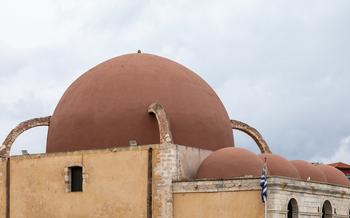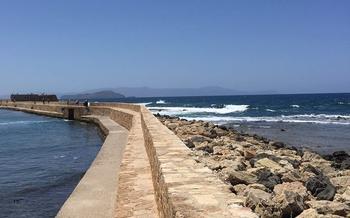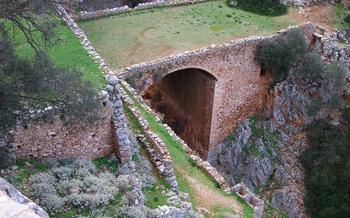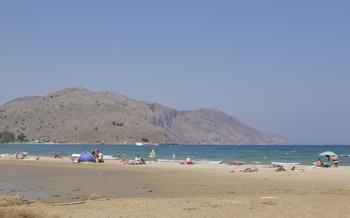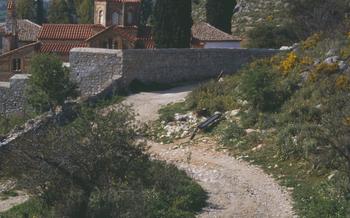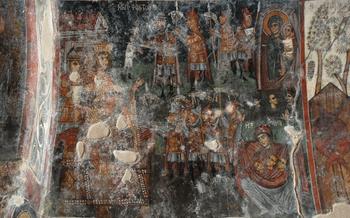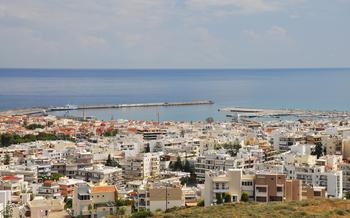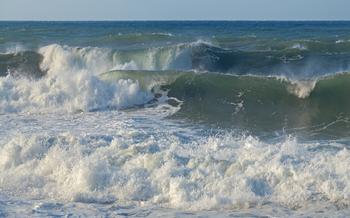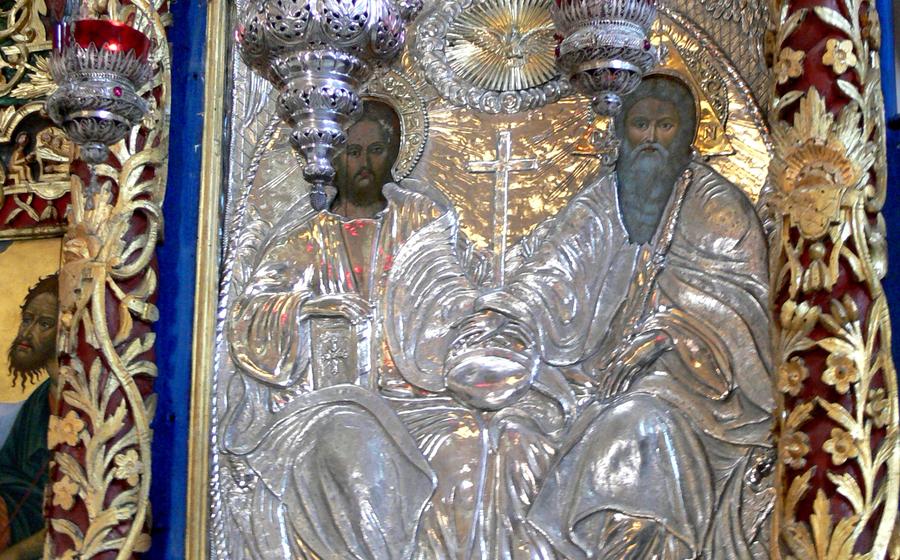
Holy Trinity Monastery (Agia Triada)
- History and Significance
- Location and Getting There
- Monastery Grounds and Architecture
- Monastic Life and Traditions
- Natural Beauty and Surroundings
- Cultural Significance and Influence
- Visiting Hours and Etiquette
- Pilgrimage and Religious Significance
- Accommodation and Amenities
- Best Time to Visit:
- Photography and Videography: Safeguarding Heritage through Responsible Capture
- Combining with Other Attractions
- Local Cuisine and Specialties
- Insider Tip: The Hidden Chapel of Saint John the Baptist
History and Significance
A Haven of Faith and Heritage
Nestled amidst the serene landscapes of Akrotiri, the Holy Trinity Monastery (Agia Triada) stands as a testament to the enduring spirit of faith and the rich cultural heritage of Chania. Founded in the 17th century by three brothers seeking refuge from worldly distractions, the monastery quickly grew in prominence, becoming a sanctuary for Orthodox Christians and a beacon of spirituality in the region.
Legends and myths intertwine with the monastery's history, adding an aura of enchantment to its sacred grounds. One tale speaks of a miraculous discovery of a holy icon by the three brothers, guiding them to establish the monastery on that very spot. The monastery's architectural style reflects a harmonious blend of Venetian and Byzantine influences, showcasing intricate stonework, elegant arches, and a majestic dome that dominates the skyline.
Location and Getting There
The Holy Trinity Monastery is nestled in the heart of the Akrotiri Peninsula, approximately 15 kilometers northeast of Chania City. To reach the monastery, visitors can embark on a scenic drive along the coast, enjoying breathtaking views of the Mediterranean Sea. The journey takes about 30 minutes by car, and rental services are readily available in Chania. Alternatively, organized guided tours offer a convenient option for those who prefer a hassle-free experience. These tours typically depart from Chania City and include round-trip transportation, allowing visitors to sit back and admire the picturesque countryside.
To ensure a smooth visit, it's advisable to plan ahead and consider the monastery's operating hours.
Monastery Grounds and Architecture
The Holy Trinity Monastery boasts an impressive architectural complex that showcases a harmonious blend of Byzantine and Venetian influences. The centerpiece of the monastery is its majestic main church, which features a remarkable dome that dominates the skyline. The interior of the church is adorned with breathtaking frescoes, depicting biblical scenes and the lives of saints, that transport visitors back in time.
Within the monastery complex, visitors can also admire the refectory, where the monks gather for communal meals. The refectory is known for its beautiful vaulted ceiling and intricate carvings. Another notable building is the bell tower, which stands tall and proud, offering panoramic views of the surrounding landscape. The living quarters of the monks, arranged around a central courtyard, provide a glimpse into their simple and austere lifestyle.
The monastery's defensive features are equally impressive, reflecting its historical role as a fortress. Fortified walls, complete with sturdy gates, surround the complex, providing protection against potential invaders. These defensive elements add to the monastery's unique character, making it a fascinating blend of spirituality and military prowess.
Monastic Life and Traditions
The Holy Trinity Monastery is a living testament to the enduring traditions of Eastern Orthodox monasticism. Within its walls, a small community of dedicated monks lead a life of prayer, contemplation, and service. Their daily routine begins before dawn, when they gather in the monastery church for morning prayers. Throughout the day, they engage in various tasks, including manual labor, gardening, and the production of religious artifacts. Meals are simple and communal, and the monks observe strict fasting periods.
Beyond their daily duties, the monks also devote themselves to spiritual practices such as meditation, chanting, and the study of scripture. They believe in the importance of silence and solitude, which they find within the monastery's peaceful surroundings. The monks also welcome visitors and pilgrims, offering them guidance and spiritual counsel. Throughout the year, the monastery hosts special ceremonies and events, such as the celebration of major religious festivals and the commemoration of saints' days. These occasions bring together the monastic community and the faithful, fostering a sense of unity and devotion.
Natural Beauty and Surroundings
The Holy Trinity Monastery is nestled in a picturesque landscape that is both serene and awe-inspiring. The monastery grounds are surrounded by lush vegetation, including olive groves, cypress trees, and fragrant herbs. The air is filled with the sound of birdsong and the gentle rustling of leaves. The monastery's location on a hilltop offers breathtaking views of the surrounding countryside, with the White Mountains rising in the distance.
The area is also home to a variety of wildlife, including birds, rabbits, and even the occasional wild goat. Visitors can enjoy hiking trails that lead through the surrounding hills and valleys, offering opportunities for birdwatching, photography, and simply enjoying the natural beauty of the region. There are also several picnic areas where visitors can relax and enjoy a meal in the tranquil surroundings.
The natural beauty of the Holy Trinity Monastery and its surroundings adds to the spiritual experience of visiting this sacred site. The peaceful atmosphere and stunning scenery create an environment that is conducive to reflection and meditation, allowing visitors to connect with nature and find inner peace.
Cultural Significance and Influence
The Holy Trinity Monastery has played a crucial role in shaping the cultural and historical identity of Chania and Crete. As a prominent religious center, the monastery has been instrumental in preserving Greek Orthodox traditions and heritage. Throughout the centuries, it has served as a refuge for scholars, artists, and religious leaders, contributing to the region's rich cultural tapestry.
The monastery's influence extends beyond its religious significance. It has been a source of inspiration for many local artists and writers, who have found solace and creativity within its walls. The monastery's architecture, icons, and natural surroundings have been depicted in numerous works of art, literature, and music, further solidifying its cultural importance.
Furthermore, the monastery has been associated with several notable personalities and events throughout history. In the 16th century, the monastery was visited by the famous Venetian painter El Greco, who was deeply moved by its beauty and spirituality. He is said to have painted several icons for the monastery, which are still on display today.
The Holy Trinity Monastery's cultural significance lies in its role as a repository of Greek Orthodox traditions, a source of inspiration for artists and intellectuals, and a place of pilgrimage and spiritual renewal. Its enduring influence continues to shape the cultural identity of Chania and Crete, making it a living testament to the region's rich history and heritage.
Visiting Hours and Etiquette
The Holy Trinity Monastery welcomes visitors throughout the year, except for certain religious holidays and special events. Opening hours are typically from 8:00 AM to 1:00 PM and 4:00 PM to 6:00 PM, but it's advisable to check the monastery's official website or contact them in advance to confirm the exact schedule.
When visiting the monastery, visitors are expected to dress modestly and respectfully. Shorts, tank tops, and revealing clothing are discouraged. It's also important to maintain silence and avoid disruptive behavior within the monastery grounds. Photography is generally allowed, but visitors should be mindful of the monks and other visitors and avoid taking photos during religious services or in areas where photography is restricted.
Pilgrimage and Religious Significance
The Holy Trinity Monastery, a revered pilgrimage site for Orthodox Christians, exudes an atmosphere of deep spirituality and religious devotion. Pilgrims from across Greece and beyond flock to this sacred site to pay homage to the monastery's holy relics, seek divine guidance, and experience the transformative power of faith.
During their pilgrimage, visitors engage in various rituals and customs to express their devotion. They light candles, offer prayers, and venerate the icons, seeking blessings and intercession from the divine. The monastery's tranquil ambiance, adorned with intricate frescoes and the gentle chanting of monks, creates a profound sense of connection with the spiritual realm.
Special services and events held throughout the year, such as the annual feast day of the Holy Trinity, attract large numbers of pilgrims. These celebrations are marked by elaborate processions, solemn liturgies, and communal feasts, fostering a sense of unity and spiritual renewal among the faithful.
For many pilgrims, the Holy Trinity Monastery represents a sanctuary of peace and solace, a place to retreat from the worldly distractions and immerse themselves in the divine presence. The monastery's sacred atmosphere and the opportunity to witness the unwavering faith of the monks leave a lasting impact on the hearts and souls of those who visit.
Accommodation and Amenities
When planning your visit to the Holy Trinity Monastery, you'll find a range of accommodation options to suit your preferences and budget. Stay in the heart of the action by choosing a hotel or guesthouse within walking distance of the monastery. These accommodations offer convenience and easy access to the monastery's grounds and surrounding attractions.
If you prefer a more immersive experience, consider staying in one of the traditional Cretan villages nearby. These charming villages offer a glimpse into the local way of life and provide a tranquil retreat after a day of exploring the monastery and its surroundings.
Regarding amenities, you'll find a selection of restaurants, cafes, and shops in the area catering to visitors and pilgrims. Indulge in delicious Cretan cuisine, sip on a refreshing beverage, or pick up souvenirs to cherish your visit. Remember to explore the local markets to discover fresh produce, handmade crafts, and other unique treasures.
Best Time to Visit:
Timing your visit to the Holy Trinity Monastery is crucial for an optimal experience. The ideal period falls between April and June when the weather is at its most pleasant, with warm, sunny days and cool nights. During this time, the monastery is adorned with blooming flowers, creating a picturesque backdrop for your visit.
Autumn (September to November) is another favorable season to visit, offering a milder climate and fewer crowds. The changing colors of the surrounding landscape add a touch of magic to your exploration.
Summer (July and August) can be hot and crowded, especially in the midday sun. However, the monastery's thick stone walls provide some respite from the heat, and the lively atmosphere during this peak season can be exhilarating.
Winter (December to March) is generally not recommended due to the unpredictable weather conditions, including rain and occasional snowfall. However, if you're seeking a serene and contemplative experience, the monastery's tranquil ambiance during this time can be quite rewarding.
Insider Tip: For those seeking a truly immersive experience, plan your visit to coincide with one of the monastery's special events or festivals. The Easter celebrations, in particular, are a sight to behold, with elaborate ceremonies and processions that showcase the monastery's rich spiritual heritage.
Photography and Videography: Safeguarding Heritage through Responsible Capture
While exploring the Holy Trinity Monastery, photography and videography can serve as cherished ways to immortalize your visit. However, it's essential to approach these activities with respect and consideration for the sacred atmosphere of the monastery.
Respecting Boundaries:
The monastery strictly prohibits photography and videography within certain areas, such as the main church's altar and the monks' living quarters. These limitations are in place to maintain the sanctity of these spaces and ensure the privacy of the monks. Please adhere to these restrictions to show your respect for the monastery's traditions and way of life.
Capturing the Essence:
When photographing or filming the monastery's architecture, focus on capturing the intricate details of the facades, domes, and arches. The interplay of light and shadow creates stunning compositions that showcase the monastery's architectural beauty.
Preserving the Tranquility:
To maintain the serene atmosphere of the monastery, avoid using flash photography or loud video equipment. These disruptions can disturb the tranquility of the grounds and detract from the spiritual experience of other visitors.
Seeking Permission:
If you wish to photograph or film any events, ceremonies, or special services taking place at the monastery, it's courteous to seek permission from the abbot or a designated monastery official. This respectful gesture ensures that your actions align with the monastery's protocols and customs.
Respecting Privacy:
When capturing images or videos of people, it's crucial to respect their privacy. Ask for consent before photographing or filming individuals, especially the monks. This simple act demonstrates your consideration for their personal space and right to privacy.
Preserving the Legacy:
By following these guidelines, you contribute to preserving the rich legacy of the Holy Trinity Monastery. Your responsible approach ensures that future generations can also appreciate and document the beauty and significance of this sacred site.
Combining with Other Attractions
The Holy Trinity Monastery is a must-see destination in Chania, but it's just one of the many incredible attractions this region has to offer. To make the most of your trip, consider combining your visit to the monastery with other nearby destinations.
Just a short drive away, you can explore the ancient city of Aptera, with its fascinating ruins and stunning views over Souda Bay. Take a leisurely stroll through the picturesque Venetian Old Town of Chania, with its charming harbor, narrow streets, and historic landmarks.
For a unique cultural experience, visit the Cretan War Museum, which houses a collection of artifacts and exhibits related to the island's rich military history. Nature enthusiasts will appreciate the Samaria Gorge, one of the longest and most impressive gorges in Europe, offering breathtaking scenery and opportunities for hiking and wildlife spotting.
Plan your itinerary carefully to allow enough time to explore these diverse attractions and create a truly memorable travel experience in Chania. Whether you're interested in history, culture, nature, or a combination of all three, this region has something to offer everyone.
Local Cuisine and Specialties
A visit to the Holy Trinity Monastery is not complete without savoring the delectable flavors of traditional Cretan cuisine. The region is known for its fresh, organic ingredients and unique culinary creations that blend ancient traditions with modern influences.
Venture into the picturesque villages surrounding the monastery and discover tavernas and restaurants that serve authentic Cretan dishes, prepared with love and passion. Indulge in mouthwatering dishes such as "dakos," a traditional salad made with barley rusks, tomatoes, feta cheese, and olive oil; "gamopilafo," a hearty wedding pilaf with lamb or goat meat; and "stifado," a beef or rabbit stew cooked in a rich tomato sauce with onions and herbs.
Don't miss the chance to try "kalitsounia," delicious pastries filled with mizithra cheese, honey, and cinnamon, or "xerotigana," crispy fried dough coated in honey syrup. These sweet treats are a testament to the region's rich culinary heritage.
For a truly immersive experience, join a cooking class or workshop to learn the secrets of Cretan cuisine from local experts. Discover the art of preparing traditional dishes using fresh, seasonal ingredients and traditional techniques.
Whether you prefer to dine in charming tavernas with panoramic views or enjoy a picnic surrounded by nature's beauty, the area around the Holy Trinity Monastery offers a culinary journey that will tantalize your taste buds and leave you with lasting memories.
Insider Tip: The Hidden Chapel of Saint John the Baptist
Venture beyond the main monastery complex and follow a discreet path leading to a hidden gem – the Chapel of Saint John the Baptist. This secluded chapel, nestled amidst a grove of ancient olive trees, offers a tranquil retreat from the monastery's bustle. Its simple yet charming architecture and serene atmosphere invite contemplation and reflection.
Legend has it that the chapel was built by a monk who sought solitude and communion with nature. As you step inside, you'll be captivated by the intricate frescoes adorning the walls, depicting scenes from the life of Saint John the Baptist. The soft light filtering through the small windows casts an ethereal glow, enhancing the sacredness of the space.
Take a moment to sit in silence, absorb the tranquility, and let the beauty of the surroundings wash over you. This hidden chapel is a true treasure, a place where you can connect with your spiritual side and find inner peace amidst the wonders of the Holy Trinity Monastery.
